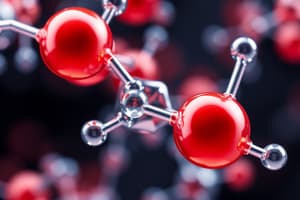Podcast
Questions and Answers
What is the atomic number of carbon?
What is the atomic number of carbon?
- 6 (correct)
- 14
- 8
- 12
What is the most common chemical property of carbon?
What is the most common chemical property of carbon?
- Combustion (correct)
- Radioactivity
- Invisibility
- Corrosion
What is the estimated percentage of carbon in the Earth's crust?
What is the estimated percentage of carbon in the Earth's crust?
- 0.03% (correct)
- 1.5%
- 10%
- 5%
What is the total number of electrons in a carbon atom?
What is the total number of electrons in a carbon atom?
What is the number of neutrons in a carbon atom?
What is the number of neutrons in a carbon atom?
What is the state of carbon at room temperature and pressure?
What is the state of carbon at room temperature and pressure?
What is the most common compound formed by carbon during combustion?
What is the most common compound formed by carbon during combustion?
What percentage of all dry biomass does carbon represent?
What percentage of all dry biomass does carbon represent?
Which process involves the intake of carbon-containing glucose for energy production?
Which process involves the intake of carbon-containing glucose for energy production?
Which molecules within the body contain carbon as the primary component?
Which molecules within the body contain carbon as the primary component?
What is the primary element used in pencils and lithium-ion batteries?
What is the primary element used in pencils and lithium-ion batteries?
Which process uses carbon dioxide from the air to produce glucose?
Which process uses carbon dioxide from the air to produce glucose?
What is the basis for life on Earth?
What is the basis for life on Earth?
What is the constant movement of carbon between reservoirs in a closed system called?
What is the constant movement of carbon between reservoirs in a closed system called?
What is the primary component of key molecules within the body?
What is the primary component of key molecules within the body?
Flashcards are hidden until you start studying
Study Notes
The Importance of Carbon in Living Organisms
- There are two allotropic forms of elemental carbon: diamonds, the hardest natural substance, and graphite, used in pencils, lithium-ion batteries, and steel reinforcement.
- Carbon is found in fuel sources, clothing, furnishings, household goods, the air, and the human body, making it essential for human survival.
- Carbon represents approximately 45-50% of all dry biomass and is the basis for life on Earth.
- Carbon has the ability to form stable bonds with many elements, allowing it to form a vast majority of molecules, including key molecules within the body.
- Key molecules within the body, such as nucleic acids, cells, proteins, carbohydrates, and lipids, contain carbon as the primary component.
- Life on Earth is known as carbon-based, containing building blocks made up of combinations of carbon and other elements.
- Organisms need carbon for essential biological processes, including reproduction, respiration, and photosynthesis.
- DNA provides instructions for organisms to develop, survive, and reproduce, made possible by carbon as a building block.
- Respiration and breathing involve the intake of carbon-containing glucose for energy production and the release of carbon dioxide as a byproduct.
- Photosynthesis in plants uses carbon dioxide from the air to produce glucose, providing energy for plant growth and survival.
- The carbon cycle involves the constant movement of carbon between reservoirs in a closed system, crucial for maintaining a stable climate and carbon balance on Earth.
- Carbon is the basic building block for most cells in the body and plays a crucial role in regulating the physiology of humans and other living organisms.
Studying That Suits You
Use AI to generate personalized quizzes and flashcards to suit your learning preferences.




